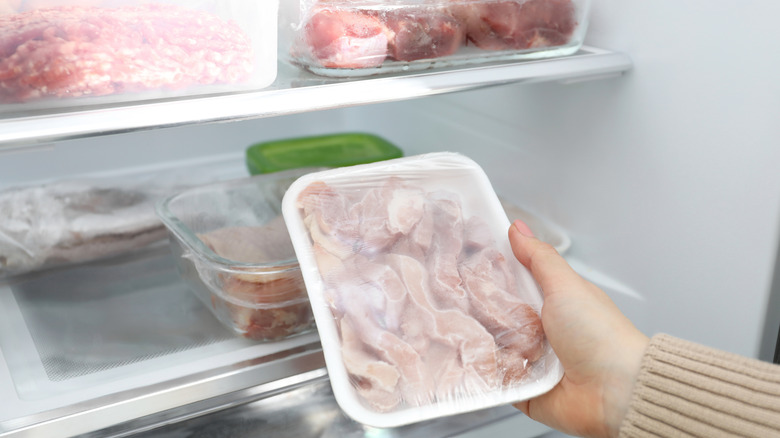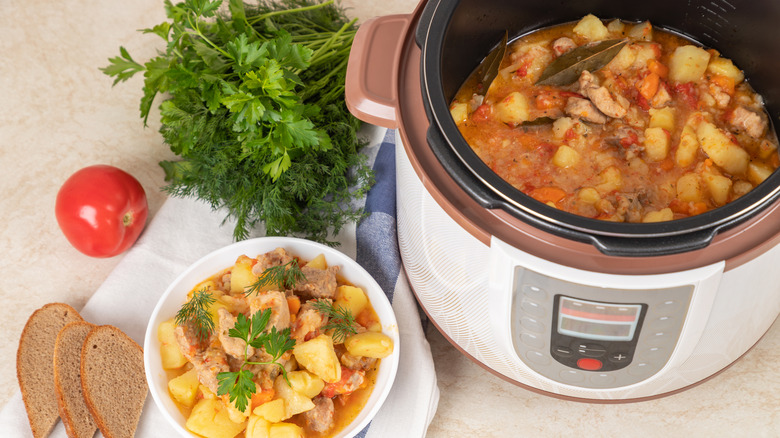Here's How Much Longer Frozen Proteins Take To Cook In An Instant Pot
We've all been there: Halfway through the day, your stomach starts growling, and then it drops because you realize you forgot to remove the chicken from the freezer that you wanted to thaw for the night's dinner. Now you have to choose between a different meal altogether or a backup plan for thawing the meat. It's a painful reality that too many of us know from our days of running errands or working in the office. Luckily, if you have an Instant Pot on the counter, all isn't lost: One of the most underrated perks of this gadget is its ability to cook meat straight from frozen, saving you from those "oops, I forgot to defrost" moments with just a 50% boost in cooking time using the Instant Pot's slow cooker setting. Just add the extra minutes to the timer and make sure you've got enough liquid in the pot to keep everything cooking evenly.
Why frozen meat takes more time in the Instant Pot
Pressure cookers, including the Instant Pot, are designed to lock in steam. This helps food cook much faster than in a conventional oven or slow cooker. Heck, it can even cook rice better than a rice cooker. But, when you're starting with frozen meat, the machine has to put in more work to bring everything up to a safe internal temperature. That initial thawing happens inside the pot during pressurization, and it's why you need to tack on extra time to your recipe.
Take chicken thighs, as an example. If you normally cook them for 10 minutes under pressure when thawed, frozen ones need closer to 15 minutes. That 50% bump is a safe rule of thumb, ensuring the meat reaches the right temperature to eat without worry. The same goes for beef, pork, and fish, so don't think the type of meat dictates whether or not you should add extra time. Sure, thinner cuts may not need a full 50% increase, but larger, denser proteins, such as roasts, definitely do.
One of the most important details to remember is the liquid. Since the Instant Pot relies on steam to build pressure, and frozen foods can release less moisture at first. Make sure whatever meat you're cooking is covered in broth, water, or sauce. Doing it this way not only helps the pot pressurize properly, it also prevents food from sticking or drying out; that extra liquid often becomes a flavorful base for gravy or soup, so it's a win-win.
Tips to get perfect results every time
Now that you know frozen proteins take longer to cook in the Instant Pot, the next step is making sure the results actually taste good. This isn't one of those moments where you can just toss large clumps of connected frozen meat into your Instant Pot. Tossing in a block of frozen chicken breasts may cause the inside to take longer to cook evenly, which runs the risk of drying out the outside. Make sure to separate the pieces before freezing, or buy individually frozen cuts, so the pressure cooker can heat them more consistently.
Another tip is to adjust seasonings after cooking. Marinades and spice rubs don't cling as well to frozen meat, so flavors can end up muted. Adding herbs, sauces, or a finishing seasoning once the meat is cooked ensures you get that burst of flavor you expect. If you're making dishes such as shredded pork or chicken, this works in your favor because you can cook the meat plain with liquid, then stir in barbecue sauce or salsa afterward.
Finally, always use a thermometer to check for doneness — don't rely on eyeballing it or assuming it's done because it's "been long enough." Even with the 50% rule, cook times can vary slightly depending on the cut, thickness, and your specific Instant Pot model. Poultry should hit 165 degrees Fahrenheit, while beef and pork vary depending on how you like them cooked (though safety guidelines recommend 145 degrees Fahrenheit or higher). Once you get comfortable with these adjustments, cooking from frozen may be your go-to instead of a backup. You also make avoiding one of the many mistakes when defrosting meat a breeze with this cheat code.


